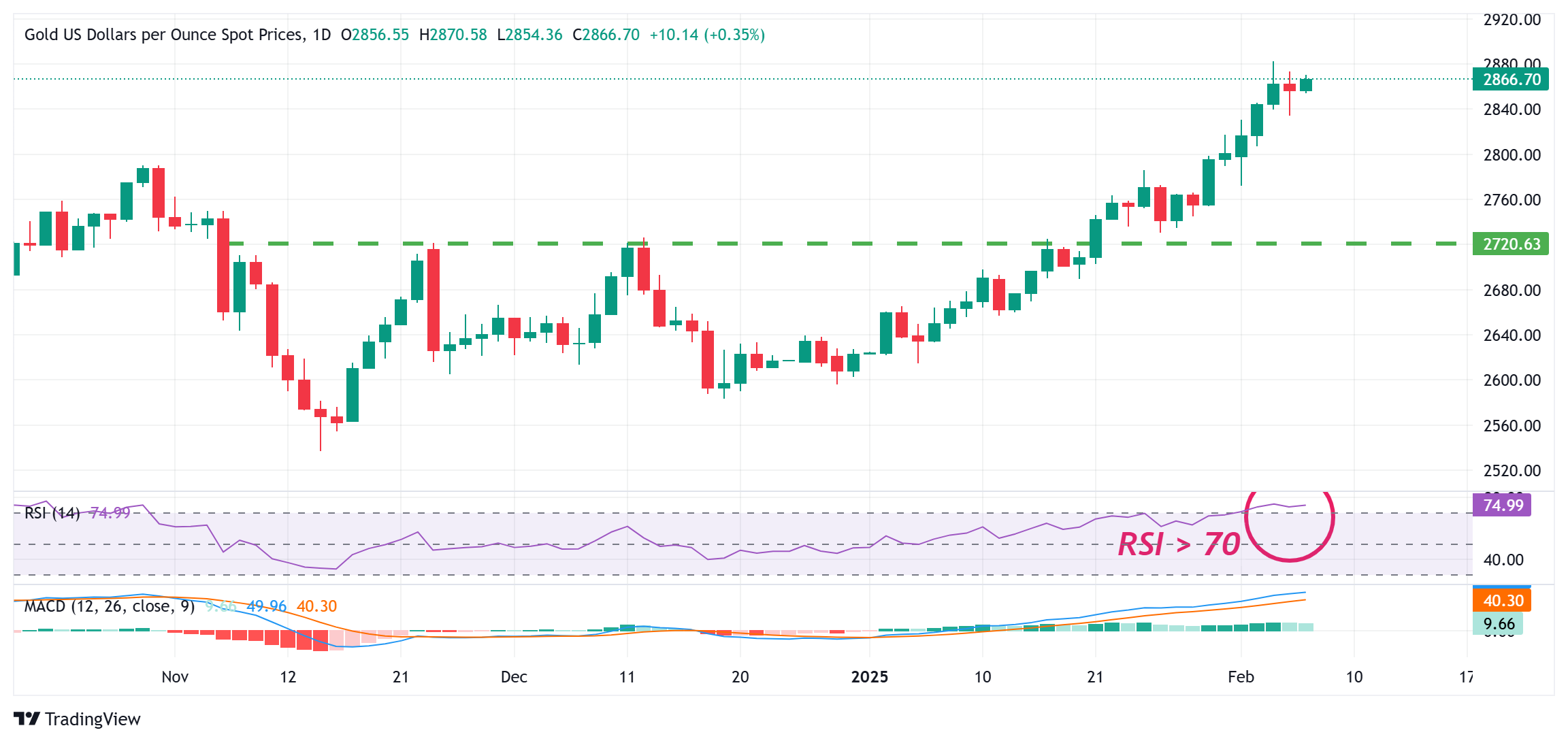Gold price remains close to all-time high; looks to US NFP for fresh impetus
- Gold price continues to attract safe-haven flows on the back of trade war fears.
- Fed rate cut bets and depressed US bond yields also support the XAU/USD pair.
- Subdued USD price action favors bulls ahead of Friday’s crucial US NFP report.
Gold price (XAU/USD) regains positive traction following the previous day's modest slide and remains within striking distance of the all-time peak during the Asian session on Friday. Escalating US-China trade tensions, along with concerns about the potential economic fallout from US President Donald Trump’s aggressive trade policies, continue to underpin demand for the safe-haven bullion.
Meanwhile, bets that the Federal Reserve (Fed) would keep cutting rates in 2025 keep the US Treasury bond yields depressed near their lowest level since December. This fails to assist the US Dollar (USD) in attracting any meaningful buyers and also lends support to the non-yielding Gold price. Traders now look forward to the release of the US Nonfarm Payrolls (NFP) report for a fresh directional impetus.
Gold price remains close to record high amid trade jitters, ahead of US NFP report
- China announced tariffs on some US goods in retaliation to US President Donald Trump's 10% levy on Chinese imports. This marks a new trade war between the world's top two economies and continues to underpin the safe-haven Gold price.
- On the economic data front, the US Department of Labor (DoL) reported on Thursday that the number of US citizens filing new applications for unemployment insurance rose to 219K for the week ending February 1, from the previous week's revised tally of 208K.
- US Treasury Secretary Scott Bessent said on Thursday that the Trump administration was not particularly concerned about the Federal Reserve's trajectory on interest rates and that the focus is on bringing down 10-year Treasury yields.
- The yield on the benchmark 10-year US government bond fell to its lowest level since December 12 earlier this week amid bets that the Federal Reserve will cut rates twice by the end of 2025, further benefitting the non-yielding yellow metal.
- Chicago Fed President Austan Goolsbee noted that the appearance that inflation has stalled is largely due to base effects and that the central bank needs to be mindful of overheating and deterioration, but things are largely going well.
- Dallas Fed President Lorie Logan said that inflation progress has been significant, but the US labor market remains far too firm to push the central bank into rate cuts any time soon. This, however, does little to impress the US Dollar bulls.
- Market participants now look forward to the US Nonfarm Payrolls report, which is expected to show that the economy added 170K jobs in January compared to 256K in the previous month and the Unemployment rate held steady at 4.1%.
- The crucial data will influence market expectations about the Fed's interest rate outlook, which, in turn, should play a key role in driving the USD demand in the near term and determining the next leg of a directional move for the XAU/USD.
Gold price needs to consolidate before traders start positioning for additional gains

From a technical perspective, the overnight bounce and the subsequent move up on Friday validates the near-term positive outlook for the Gold price. That said, the Relative Strength Index (RSI) is flashing slightly overbought conditions on the day chart and warrants some caution for bullish traders. Hence, it will be prudent to wait for some near-term consolidation before positioning for an extension of the recent well-established uptrend from the December monthly trough.
In the meantime, the $2,855 horizontal zone, followed by the overnight swing low, around the $2,834 region, could offer some support to the Gold price ahead of the $2,815-2,714 region. This is followed by the $2,800 mark, which if broken decisively might prompt some technical selling and drag the XAU/USD towards the $2,773-2,772 resistance breakpoint. The latter coincides with the weekly low and a convincing break below should pave the way for a deeper corrective decline.
Gold FAQs
Gold has played a key role in human’s history as it has been widely used as a store of value and medium of exchange. Currently, apart from its shine and usage for jewelry, the precious metal is widely seen as a safe-haven asset, meaning that it is considered a good investment during turbulent times. Gold is also widely seen as a hedge against inflation and against depreciating currencies as it doesn’t rely on any specific issuer or government.
Central banks are the biggest Gold holders. In their aim to support their currencies in turbulent times, central banks tend to diversify their reserves and buy Gold to improve the perceived strength of the economy and the currency. High Gold reserves can be a source of trust for a country’s solvency. Central banks added 1,136 tonnes of Gold worth around $70 billion to their reserves in 2022, according to data from the World Gold Council. This is the highest yearly purchase since records began. Central banks from emerging economies such as China, India and Turkey are quickly increasing their Gold reserves.
Gold has an inverse correlation with the US Dollar and US Treasuries, which are both major reserve and safe-haven assets. When the Dollar depreciates, Gold tends to rise, enabling investors and central banks to diversify their assets in turbulent times. Gold is also inversely correlated with risk assets. A rally in the stock market tends to weaken Gold price, while sell-offs in riskier markets tend to favor the precious metal.
The price can move due to a wide range of factors. Geopolitical instability or fears of a deep recession can quickly make Gold price escalate due to its safe-haven status. As a yield-less asset, Gold tends to rise with lower interest rates, while higher cost of money usually weighs down on the yellow metal. Still, most moves depend on how the US Dollar (USD) behaves as the asset is priced in dollars (XAU/USD). A strong Dollar tends to keep the price of Gold controlled, whereas a weaker Dollar is likely to push Gold prices up.
US-China Trade War FAQs
Generally speaking, a trade war is an economic conflict between two or more countries due to extreme protectionism on one end. It implies the creation of trade barriers, such as tariffs, which result in counter-barriers, escalating import costs, and hence the cost of living.
An economic conflict between the United States (US) and China began early in 2018, when President Donald Trump set trade barriers on China, claiming unfair commercial practices and intellectual property theft from the Asian giant. China took retaliatory action, imposing tariffs on multiple US goods, such as automobiles and soybeans. Tensions escalated until the two countries signed the US-China Phase One trade deal in January 2020. The agreement required structural reforms and other changes to China’s economic and trade regime and pretended to restore stability and trust between the two nations. However, the Coronavirus pandemic took the focus out of the conflict. Yet, it is worth mentioning that President Joe Biden, who took office after Trump, kept tariffs in place and even added some additional levies.
The return of Donald Trump to the White House as the 47th US President has sparked a fresh wave of tensions between the two countries. During the 2024 election campaign, Trump pledged to impose 60% tariffs on China once he returned to office, which he did on January 20, 2025. With Trump back, the US-China trade war is meant to resume where it was left, with tit-for-tat policies affecting the global economic landscape amid disruptions in global supply chains, resulting in a reduction in spending, particularly investment, and directly feeding into the Consumer Price Index inflation.

